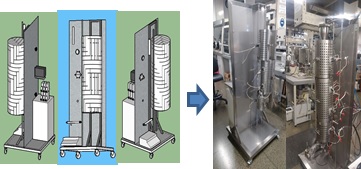
Andrés Muñoz
University of Antioquia, Colombia
Title: Study of a Fluidized Bed Reactor to Produce Green-Carbon Nanotubes at Pilot Scale
Biography
Biography: Andrés Muñoz
Abstract
Carbon nanotubes are materials of great scientific and technological interest that has called attention of many scientists, since the discovery of them by Ijima in 1991[1]; This great interest due to their unique physical and chemical properties such as chemical corrosion resistance, thermal stability, high thermal and electrical conductivity, low density and high mechanical strength.
The present work shows an experimental fluidized bed catalytic chemical vapor deposition reactor (see Figure), as the best technology to produce carbon nanotubes, using a clean process that allows the simultaneous production of hydrogen, based on catalytic decomposition of ethanol, which is a renewable carbon source, and a catalyst based on nickel. Operational parameters as initial catalyst amount, fluidization velocity, temperature and residence time, was analyzed and optimized for the experimental design, making the respective experiments to obtain a kinetic model of the reactor.
As results was found that the granulometric distribution size of the catalyst have an impact in the yield of the reaction, being increased as the size down; the nature and behavior of the catalyst inside the reactor affect the requirements to keep the fluidization regimen, increasing the inlet flow of gases when agglomeration of catalyst is created with the increase of the temperature inside the reactor; the time of reaction, to obtain the same yield is decreased while the gas concentration of the ethanol is increased in the inlet gases; the outer diameter of the CNTs strongly depends on the reaction temperature; an increase of the reaction temperature leads to an increase in H2 production, this associated with the thermal decomposition of the ethanol and the CNT production; finally the TEM micrographs show that the nanotubes were multi-walled for the range of conditions studied. The production of carbonaceous materials (mainly carbon nanotubes) was between 1 g/g catalyst and 14 g/g catalyst.
Materials, catalysts, and reaction products was characterized using analytical techniques such as XRD, TGA, SEM, TEM.

Figure. Design and laboratory experimental set up of the fluidized bed Reactor for the production of CNT.
Recent Publications
1. Q. Weizhong et al., “Production of carbon nanotubes in a packed bed and a fluidized bed,” AIChE J., vol. 49, no. 3, pp. 619–625, 2003.
2. E. M. S. Dresselhaus, G. Dresselhaus, and P. Avouris, Carbon Nanotubes, vol. 4216, no. 2001. 2003.
3. R. Philippe et al., “Catalytic production of carbon nanotubes by fluidized-bed CVD,” Chem. Vap. Depos., vol. 13, no. 9, pp. 447–457, 2007.
4. A. Morançais et al., “A parametric study of the large scale production of multi-walled carbon nanotubes by fluidized bed catalytic chemical vapor deposition,” Carbon N. Y., vol. 45, no. 3, pp. 624–635, 2007.

